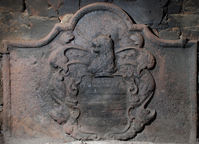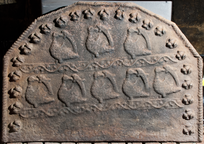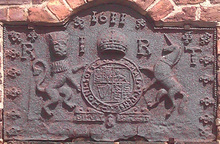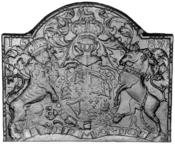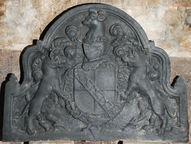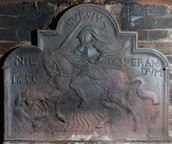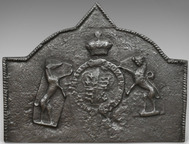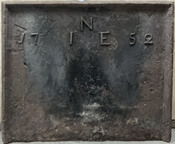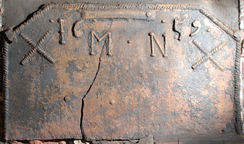-
913
Description: Rectangular with an arched rectangular style arch linked by symmetrical concave curves; ovolo moulding (top and sides); shield, helm, crest and mantling of the Fuller family. A number 7, the only visible part of the date seen on other castings is in the top right corner of the shield.
Notes: A carved armorial on a plain, edged base board; the arms of the Fullers of Brightling Park, Sussex: Argent, three bars and a canton gules; the crest; Out of a ducal coronet Or, a lion’s head argent; the Fullers were iron masters and gun founders in the first half of the 18th century, operating Heathfield furnace, where it is likely that this fireback was cast.
Inscription: [1] 7 / [4] [7]
Arms: Fuller, of Brightling, Sussex
- Decoration tags:
- rectangular with round arch (shape)
- ovolo (edging)
- carved pattern panels
- armorial
Manufactured: in 1747 probably at Heathfield Furnace in the Weald area of England.
Current location: in private hands, Brightling, East Sussex, England.
- Attached to series:
- Ironmasters armorial series
- Personal armorial firebacks
-
1201
Description: Rectangular with five-facetted arched shape; twisted rope edging (top and sides); small flower-bud stamp repeated 23 times inside the edging; across the middle of the fireback, two approximately parallel lines of lengths of vine strip moulding inclined up to the right; between them, five bird stamps, probably swans (a Lancastrian badge), the front of their left wings 'displayed and inverted', and three more swans above the top line of vine strip moulding.
Notes: The stamps are all seen on other firebacks in the same series. The five-facetted arch is seemingly unique. A very similar fireback with minor differences was lot 2630 at Toovey's auction, Washington, West Sussex, 19 Jun 2015.
Copies of this fireback are known.
- Decoration tags:
- multi-facet arched (shape)
- rope (edging)
- carved stamps
- animals
- objects
Manufactured: in the late-16th century possibly at Pounsley Furnace, Framfield in the Weald area of England.
Current location: in private hands, Chiddingstone, Kent, England.
- Attached to series:
- Pounsley series
- Swan series
- Vine strip series
-
968
Description: Rectangular; truncated egg and dart moulded edging on top and left side; top right of centre, date in individual over-pressed stamps; initials in over-pressed stamps centred below date.
Notes: A rare use of egg and dart moulding used as separate edging, presumably derived from redundant domestic moulding or furniture.
Inscription: 1637 / H V
- Decoration tags:
- rectangular (shape)
- egg and dart (edging)
- individual letters
- individual numbers
- text
Manufactured: in 1637 possibly in the Weald area of England.
Current location: in private hands, Cowden, Kent, England.
- Attached to series:
- Date & initials firebacks
-
967
Description: Arched rectangular shape; twisted rope edging; central shield, garter, supporters, motto and crown; date in arch; initials 'I R' (Iacobus Rex) separated by crown; initials 'R T' separated by supporters, and level with other initials; fleur-de-lys stamp repeated 16 times, one each side of date, two on each shoulder of plate, five down each side.
Notes: A naively carved armorial of James I. The initials 'RT' are likely to be those of the person who commissioned the fireback. A fireback with an identical armorial, supporters and royal initials, dated 1633, was recorded by Alfred Watkins at Fawley Court, Brockhampton, Herefordshire, before 1918 (but now no longer in situ).
Inscription: 1611 / R I R T / HONY SOIT QVI MAL Y PENSE / [motto illegible]
Arms: English Stuart royal
- Decoration tags:
- rectangular with round arch (shape)
- rope (edging)
- whole carved pattern
- individual letters
- individual numbers
- heraldic
- armorial
- text
Manufactured: in 1611 in England.
Current location: 48 Scotland Street, Ellesmere, Shropshire, England.
- Attached to series:
- Stuart royal armorial firebacks
-
92
Description: Arched rectangular shaped; paternost bead edging (top and sides); Stuart royal arms: shield, garter, helm, crown, crest, supporters and motto; date split between top corners; initials split beneath supporters.
Notes: Firebacks with royal arms attributable to the reign of James II are, inevitably, uncommon owing to the brevity of his reign. Paternost beads are more usually found as edging on ‘Dutch’ types of fireback. A polychrome casting of this fireback is displayed as the royal arms in St James's church in North Cray, Kent.
Copies of this fireback are known.
Inscription: 1687 /HONI SOIT QUI MAL Y PENSE / I R / DIEU ET MON DROIT
Arms: English Stuart royal (James II)
- Decoration tags:
- rectangular with round arch (shape)
- bead-and-pellett (edging)
- whole carved pattern
- individual numbers
- armorial
- royal
- text
Manufactured: in 1687 possibly in the Weald area of England.
Current location: Hampton Court, Richmond, Greater London, England.
Museum number: 1010 (part of the Royal Collection museum group)
- Attached to series:
- James II royal armorial firebacks
- Stuart royal armorial firebacks
-
491
Description: Armorial; one plank line; shield, supporters, helm, crest and garter of the Sackville family: quarterly or and gules, a bend vair.
Notes: The arms of Thomas Sackville (1527-1608), created 1st Baron Buckhurst in 1567 and invested Knight of the Garter in 1589. He was MP for East Grinstead. He was created 1st Earl of Dorset in 1604; the back therefore dates between 1589 and 1604.
Copies of this fireback are known.
Inscription: HONI ... MAL Y PEN ...
Arms: Sackville, Baron Buckhurst
- Decoration tags:
- complex quasi-arched (shape)
- ovolo (edging)
- whole carved pattern
- planklines
- armorial
- text
Manufactured: in the late-16th to early-17th century in the Weald area of England.
Current location: Michelham Priory, Arlington, East Sussex, England.
(part of the Sussex Archaeological Society museum group)
Citation: Butterfield, W. R., 1916, 'Old Wealden Firebacks', The Connoisseur, 46, pp. 197-209.
- Attached to series:
- Ornate border series
- Personal armorial firebacks
- Sackville firebacks
-
657
Description: Rectangular with curved top corners; Arched rectangular extension on top; ovolo edging; mounted figure in 17th cent. armour riding down a dragon to the left and below, sword in hand; inscription across top and either side of horseman; date below left; initials below right.
Notes: Probably a representation of St George and the Dragon, with political undertones, given the date. Cursius may be a mis-spelling of Marcus Curtius, who sacrificed himself for the good of Rome. Nil Desperandum - Despair not. Other firebacks also bear the initials, IM, which probably relate to the pattern maker, some with a similar style of lettering.
Copies of this fireback are known.
Inscription: CVRSIVS / NIL DESPERANDVM / 1650 / IM
- Decoration tags:
- rectangular with round arch (shape)
- ovolo (edging)
- whole carved pattern
- pictorial
- allegorical
- text
- animals
- humans
Manufactured: in 1650 possibly at Brede Furnace in the Weald area of England.
Current location: in private hands, Rolvenden, Kent, England.
- Attached to series:
- IM series
- Hooked '1' series
- Brede group
-
51
Description: Arched rectangular shaped, topped with a triangle; twisted rope edging (top and sides only); inverted Tudor royal shield and Garter, crown above, greyhound and lion supporters (see example at Alfriston Clergy House). Two horizontal planklines.
Notes: A uniquely shaped fireback, the inverted shield and Garter indicate that they formed a separate stamp from the crown; other firebacks with these stamps have the shield and Garter the correct way round. A frequently copied fireback; a larger version has a bottom extension.
Copies of this fireback are known.
Inscription: HONE SOVT QUEY MAL Y PENSE
Arms: Tudor royal (prob.Henry VIII)
- Decoration tags:
- rectangular with round arch and triangle above (shape)
- rope (edging)
- carved stamps
- planklines
- heraldic
- armorial
- royal
Manufactured: in the early- to mid-16th century possibly at Pounsley Furnace, Framfield in the Weald area of England.
Current location: Courtlands, Taunton, Somerset, England.
- Attached to series:
- Pounsley series
- Tudor royal armorial firebacks
-
1249
Description: Rectangular; bold ovolo-moulded edging (top and sides); at top, date widely split by initials in triad.
Notes: Characteristic lettering and numerals of the mid-18th century. The triad of initials probably refer to a husband and wife, the central initial N being that of their surname.
Inscription: 17 INE [triad] 52
- Decoration tags:
- rectangular (shape)
- ovolo (edging)
- carved stamps
- individual letters
- individual numbers
Manufactured: in 1752 possibly in the Weald area of England.
Current location: Authentic Reclamation, Lymden Lane, Ticehurst, East Sussex, England.
- Attached to series:
- Date & initials firebacks
-
725
Description: Canted rectangle with twisted rope edging; uneven, individually stamped letters and numerals, the initials separating the two parts of the date, which are raised slightly higher; dots are stamped on each side of each half of the date and between the initials; a twisted rope saltire at each end of the inscription.
Notes: The distinctive form of the number '5' has been seen on another fireback indicating a common source (no. 946). The plate above the inscription is a repair, as are the rivets either side of the crack.
Inscription: ·16· M · N ·59·
- Decoration tags:
- rectangular with canted top corners (shape)
- rope (edging)
- simple stamps
- carved stamps
- individual letters
- individual numbers
- apotropaic
- text
- objects
Manufactured: in 1659 in the Weald area of England.
Current location: in private hands, Upper Beeding, West Sussex, England.
- Attached to series:
- Date & initials firebacks
- Rope design firebacks
- Shortened '5' series
